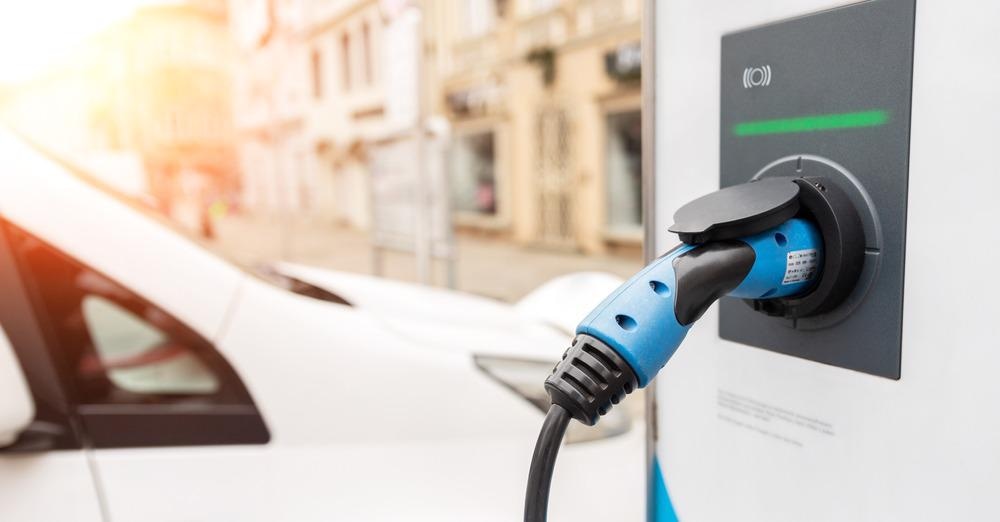The shift from the use of traditional fossil fuel-powered vehicles to electric vehicles will play an important part in reducing the world’s greenhouse gas emissions and achieving the Paris Agreement’s goals of limiting global warming to below 1.5 °C. Recent figures show that only 3% of the world’s cars are currently electric and although this is expected to rise, there are numerous barriers to the widespread adoption of electric vehicles such as consumer anxiety over running out of electricity while making a journey.

Image Credit: Gorlov-KV/Shutterstock.com
A multinational leader in the industrial solutions sector of the Nidec Group, Nidec ASI, is addressing this need for charging infrastructure with the installation of an ultra-fast charging solution on the Telesina state highway in Italy. The innovation is an important step in electric vehicle development. The ultra-fast charger will likely encourage the use of electric vehicles, boosting electric vehicle production and reducing reliance on traditional vehicles with large carbon footprints.
The Environmental Benefit of Driving Electric Cars
The world must implement numerous strategies simultaneously to tackle climate change. Cars are a major source of greenhouse gas emissions, with the average car emitting roughly 24 pounds of greenhouse gases per gallon of gas it uses.
In the US, the use of cars and trucks accounts for around 20% of the country’s total annual emissions. Therefore, reducing emissions related to personal vehicles presents a huge opportunity to reduce global emissions. While there is some controversy over the true ‘greenness’ of electric vehicles, given that the electricity they run on is still produced mainly from fossil fuels as is the energy used in production, recent research has demonstrated that carbon emissions associated with electric car use are roughly 17-30% less than those emitted when driving a petrol or diesel car. Electric cars have the potential in the future to be powered by clean energy, as countries improve their green energy infrastructure.
While the benefit of driving electric cars has been proven, in terms of lowering emissions, numerous barriers to widespread adoption remain, including consumer concern over vehicle costs, driving ranges, charging times, and charging infrastructure. With the advent of Nidec’s Ultra Fast Charger (UFC) station, some of these key consumer worries are answered.
The new system can also charge electric vehicles in less than 15 minutes, guaranteeing consumers an efficient means of charging their vehicle and, while keeping the impact on the grid to a minimum. The ultra-fast charging solution will help to make the future of all-electric vehicles a reality, which will help to reduce the emissions associated with the transport industry. It will also help to develop the required infrastructure to support the increase in electric vehicle use, allowing it to grow without barriers.
Nidec’s Ultra-Fast Charging Solution
Currently, charging points for electric vehicles rely significantly on the energy provided by the national grid. Nidec’s solution alleviates this while speeding up the electrification process of infrastructure implemented to charge electric vehicles.
The system can respond efficiently to increases in energy demand from charging points while maintaining maximum electrical grid stability. It can also successfully charge cars, buses, and commercial vehicles without relying on energy produced by the grid. Nidec’s ultra-fast charger uses battery energy storage that acts as a buffer between the electrical grid energy source and the charging point.
The ultra-fast charging solution is the most advanced new generation of ultra-fast chargers currently available. It can be connected to both LV and MV grids and supply up to 320 kW of power to a single vehicle. As a result, new-generation electric car batteries can reach 80% of their capacity in under 15 minutes. The system can also charge vehicles in both parallel and series. Finally, the compact size of the new system means that it can easily be distributed across regions to meet the growing need for sophisticated and well-connected electric vehicle infrastructure.
The Future of Electric Vehicles
The widespread adoption of electric vehicles presents an opportunity to significantly reduce global emissions and induce a sustainable reduction in greenhouse gas emissions from the transportation industry.
In the near future, as electricity production becomes less carbon-intensive, the use of electric vehicles will have an even smaller carbon footprint than it currently does, helping to decrease global emissions further. Conventional petrol and diesel vehicles, on the other hand, are limited in terms of their potential to mitigate global emissions.
Innovations such as Nidec’s ultra-fast charging solution will likely play a vital role in helping the world to meet the goals of the Paris Agreement to protect the planet from climate change.
References and Further Reading
Hausfather, Zeke. (2019) Factcheck: How electric vehicles help to tackle climate change. Carbon Brief. [Online] Available at: https://www.carbonbrief.org/factcheck-how-electric-vehicles-help-to-tackle-climate-change
Nidec ASI to install its Ultra Fast Charger - designed to charge new generation e-vehicles - a new milestone in promoting more sustainable mobility. (2021) Process and Control Today. [Online] Available at: https://www.pandct.com/news/nidec-asi-to-install-its-ultra-fast-charger-designed-to-charge-new-generation-e-vehicles-a-new-milestone-in-promoting-more-sustainable-mobility/
Nidec industrial solutions presents the new ultra fast charger. (2018) Nidec. [Online] Available at: https://www.nidec-industrial.com/nidec-industrial-solutions-presents-new-ultra-fast-charger/
Disclaimer: The views expressed here are those of the author expressed in their private capacity and do not necessarily represent the views of AZoM.com Limited T/A AZoNetwork the owner and operator of this website. This disclaimer forms part of the Terms and conditions of use of this website.